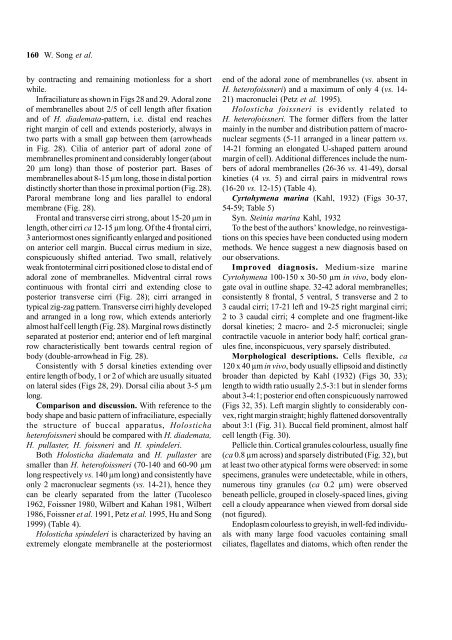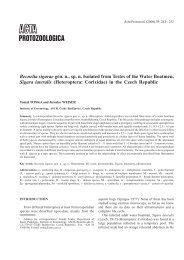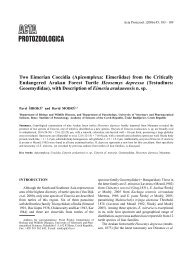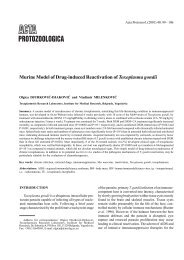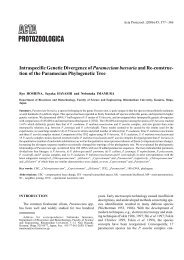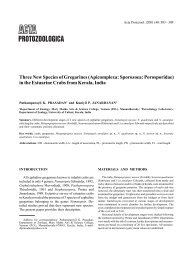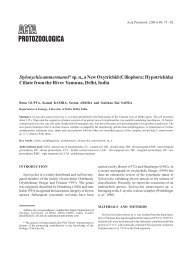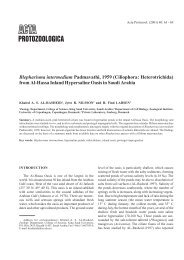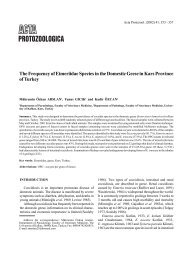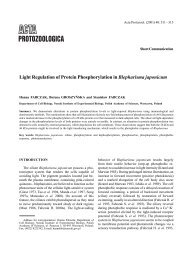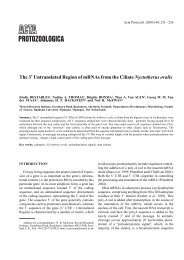New Contribution to the Morphology and Taxonomy of Four Marine ...
New Contribution to the Morphology and Taxonomy of Four Marine ...
New Contribution to the Morphology and Taxonomy of Four Marine ...
Create successful ePaper yourself
Turn your PDF publications into a flip-book with our unique Google optimized e-Paper software.
160 W. Song et al.<br />
by contracting <strong>and</strong> remaining motionless for a short<br />
while.<br />
Infraciliature as shown in Figs 28 <strong>and</strong> 29. Adoral zone<br />
<strong>of</strong> membranelles about 2/5 <strong>of</strong> cell length after fixation<br />
<strong>and</strong> <strong>of</strong> H. diademata-pattern, i.e. distal end reaches<br />
right margin <strong>of</strong> cell <strong>and</strong> extends posteriorly, always in<br />
two parts with a small gap between <strong>the</strong>m (arrowheads<br />
in Fig. 28). Cilia <strong>of</strong> anterior part <strong>of</strong> adoral zone <strong>of</strong><br />
membranelles prominent <strong>and</strong> considerably longer (about<br />
20 µm long) than those <strong>of</strong> posterior part. Bases <strong>of</strong><br />
membranelles about 8-15 µm long, those in distal portion<br />
distinctly shorter than those in proximal portion (Fig. 28).<br />
Paroral membrane long <strong>and</strong> lies parallel <strong>to</strong> endoral<br />
membrane (Fig. 28).<br />
Frontal <strong>and</strong> transverse cirri strong, about 15-20 µm in<br />
length, o<strong>the</strong>r cirri ca 12-15 µm long. Of <strong>the</strong> 4 frontal cirri,<br />
3 anteriormost ones significantly enlarged <strong>and</strong> positioned<br />
on anterior cell margin. Buccal cirrus medium in size,<br />
conspicuously shifted anteriad. Two small, relatively<br />
weak fron<strong>to</strong>terminal cirri positioned close <strong>to</strong> distal end <strong>of</strong><br />
adoral zone <strong>of</strong> membranelles. Midventral cirral rows<br />
continuous with frontal cirri <strong>and</strong> extending close <strong>to</strong><br />
posterior transverse cirri (Fig. 28); cirri arranged in<br />
typical zig-zag pattern. Transverse cirri highly developed<br />
<strong>and</strong> arranged in a long row, which extends anteriorly<br />
almost half cell length (Fig. 28). Marginal rows distinctly<br />
separated at posterior end; anterior end <strong>of</strong> left marginal<br />
row characteristically bent <strong>to</strong>wards central region <strong>of</strong><br />
body (double-arrowhead in Fig. 28).<br />
Consistently with 5 dorsal kineties extending over<br />
entire length <strong>of</strong> body, 1 or 2 <strong>of</strong> which are usually situated<br />
on lateral sides (Figs 28, 29). Dorsal cilia about 3-5 µm<br />
long.<br />
Comparison <strong>and</strong> discussion. With reference <strong>to</strong> <strong>the</strong><br />
body shape <strong>and</strong> basic pattern <strong>of</strong> infraciliature, especially<br />
<strong>the</strong> structure <strong>of</strong> buccal apparatus, Holosticha<br />
heter<strong>of</strong>oissneri should be compared with H. diademata,<br />
H. pullaster, H. foissneri <strong>and</strong> H. spindeleri.<br />
Both Holosticha diademata <strong>and</strong> H. pullaster are<br />
smaller than H. heter<strong>of</strong>oissneri (70-140 <strong>and</strong> 60-90 µm<br />
long respectively vs. 140 µm long) <strong>and</strong> consistently have<br />
only 2 macronuclear segments (vs. 14-21), hence <strong>the</strong>y<br />
can be clearly separated from <strong>the</strong> latter (Tucolesco<br />
1962, Foissner 1980, Wilbert <strong>and</strong> Kahan 1981, Wilbert<br />
1986, Foissner et al. 1991, Petz et al. 1995, Hu <strong>and</strong> Song<br />
1999) (Table 4).<br />
Holosticha spindeleri is characterized by having an<br />
extremely elongate membranelle at <strong>the</strong> posteriormost<br />
end <strong>of</strong> <strong>the</strong> adoral zone <strong>of</strong> membranelles (vs. absent in<br />
H. heter<strong>of</strong>oissneri) <strong>and</strong> a maximum <strong>of</strong> only 4 (vs. 14-<br />
21) macronuclei (Petz et al. 1995).<br />
Holosticha foissneri is evidently related <strong>to</strong><br />
H. heter<strong>of</strong>oissneri. The former differs from <strong>the</strong> latter<br />
mainly in <strong>the</strong> number <strong>and</strong> distribution pattern <strong>of</strong> macronuclear<br />
segments (5-11 arranged in a linear pattern vs.<br />
14-21 forming an elongated U-shaped pattern around<br />
margin <strong>of</strong> cell). Additional differences include <strong>the</strong> numbers<br />
<strong>of</strong> adoral membranelles (26-36 vs. 41-49), dorsal<br />
kineties (4 vs. 5) <strong>and</strong> cirral pairs in midventral rows<br />
(16-20 vs. 12-15) (Table 4).<br />
Cyr<strong>to</strong>hymena marina (Kahl, 1932) (Figs 30-37,<br />
54-59; Table 5)<br />
Syn. Steinia marina Kahl, 1932<br />
To <strong>the</strong> best <strong>of</strong> <strong>the</strong> authors’ knowledge, no reinvestigations<br />
on this species have been conducted using modern<br />
methods. We hence suggest a new diagnosis based on<br />
our observations.<br />
Improved diagnosis. Medium-size marine<br />
Cyr<strong>to</strong>hymena 100-150 x 30-50 µm in vivo, body elongate<br />
oval in outline shape. 32-42 adoral membranelles;<br />
consistently 8 frontal, 5 ventral, 5 transverse <strong>and</strong> 2 <strong>to</strong><br />
3 caudal cirri; 17-21 left <strong>and</strong> 19-25 right marginal cirri;<br />
2 <strong>to</strong> 3 caudal cirri; 4 complete <strong>and</strong> one fragment-like<br />
dorsal kineties; 2 macro- <strong>and</strong> 2-5 micronuclei; single<br />
contractile vacuole in anterior body half; cortical granules<br />
fine, inconspicuous, very sparsely distributed.<br />
Morphological descriptions. Cells flexible, ca<br />
120 x 40 µm in vivo, body usually ellipsoid <strong>and</strong> distinctly<br />
broader than depicted by Kahl (1932) (Figs 30, 33);<br />
length <strong>to</strong> width ratio usually 2.5-3:1 but in slender forms<br />
about 3-4:1; posterior end <strong>of</strong>ten conspicuously narrowed<br />
(Figs 32, 35). Left margin slightly <strong>to</strong> considerably convex,<br />
right margin straight; highly flattened dorsoventrally<br />
about 3:1 (Fig. 31). Buccal field prominent, almost half<br />
cell length (Fig. 30).<br />
Pellicle thin. Cortical granules colourless, usually fine<br />
(ca 0.8 µm across) <strong>and</strong> sparsely distributed (Fig. 32), but<br />
at least two o<strong>the</strong>r atypical forms were observed: in some<br />
specimens, granules were undetectable, while in o<strong>the</strong>rs,<br />
numerous tiny granules (ca 0.2 µm) were observed<br />
beneath pellicle, grouped in closely-spaced lines, giving<br />
cell a cloudy appearance when viewed from dorsal side<br />
(not figured).<br />
Endoplasm colourless <strong>to</strong> greyish, in well-fed individuals<br />
with many large food vacuoles containing small<br />
ciliates, flagellates <strong>and</strong> dia<strong>to</strong>ms, which <strong>of</strong>ten render <strong>the</strong>


